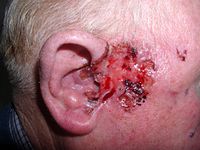
Photo from wikipedia
INTRODUCTION Data regarding treatment and survival outcome of patients with mucoepidermoid carcinoma of the head and neck are limited to case reports and case series. As a consequence of lacking… Click to show full abstract
INTRODUCTION Data regarding treatment and survival outcome of patients with mucoepidermoid carcinoma of the head and neck are limited to case reports and case series. As a consequence of lacking evidence, treatment guidelines do not exist. We aimed to analyze the effect of modern radiotherapy in form of intensity modulated radiotherapy (IMRT) either with simultaneously integrated boost or carbon ion boost on local control and survival for a relatively large patient collective. MATERIALS AND METHODS Patient records of 62 consecutive patients treated with postoperative (n = 53, 85%) or definitive (n = 9, 15%) radiotherapy between 2004 and 2019 were analyzed retrospectively. Kaplan-Meier estimates for overall survival (OS), distant progression-free survival (PFS), local control (LC) and locoregional control (LRC) were statistically calculated and prognostic factors were identified using the log-rank test. Toxicity was assessed according to the Common Terminology Criteria for Adverse Events (CTCAE). RESULTS The median follow-up was 47 months (range, 4-188 months). The 3-year OS, DPFS, LC and LRC, estimated by Kaplan-Meier curves, were 82%, 87%, 89% and 92%, the estimated 5-year OS, DPFS, LC and LRC were 78%, 87%, 84% and 88%, respectively. In univariate analysis, age >56 years (vs. age ≤56 years) was identified as the only independent negative prognostic factor for decreased OS (HR = 1.078; 95%-CI = 1.029-1.130; p = 0.001), DPFS (HR = 1.055; 95%-CI = 1.000-1.114; p = 0.051) and LC (HR = 1.087; 95%-CI = 1.022-1.157; p = 0.008). Treatment was well tolerated without any grade ≥4 toxicity. Acute and late grade 3 toxicities were rare with 16% acute (n = 10) and 13% late toxicities (n = 8). CONCLUSION Radiotherapy with intensity modulated radiotherapy including either simultaneously integrated photon boost or active raster-scanning carbon ion boost for mucoepidermoid carcinomas of the head and neck resulted in excellent survival outcome and locoregional control with moderate toxicity. However, patients older than 56 years seem to have a disadvantage in all calculated endpoints (OS, DPFS, LRC) due to frequent local and distant relapses. CONDENSED ABSTRACT Modern radiotherapy with intensity modulated radiotherapy including either a simultaneously integrated photon boost or carbon ion boost for mucoepidermoid carcinoma results in excellent survival outcome and locoregional control with moderate toxicity. The 5-year OS, DPFS, LC and LRC, estimated by Kaplan-Meier curves, were 89%, 75%, 84% and 80%, respectively. Patients older than 56 years seem to have a disadvantage in all calculated endpoints (OS, DPFS, LRC).
Journal Title: Oral oncology
Year Published: 2019
Link to full text (if available)
Share on Social Media: Sign Up to like & get
recommendations!